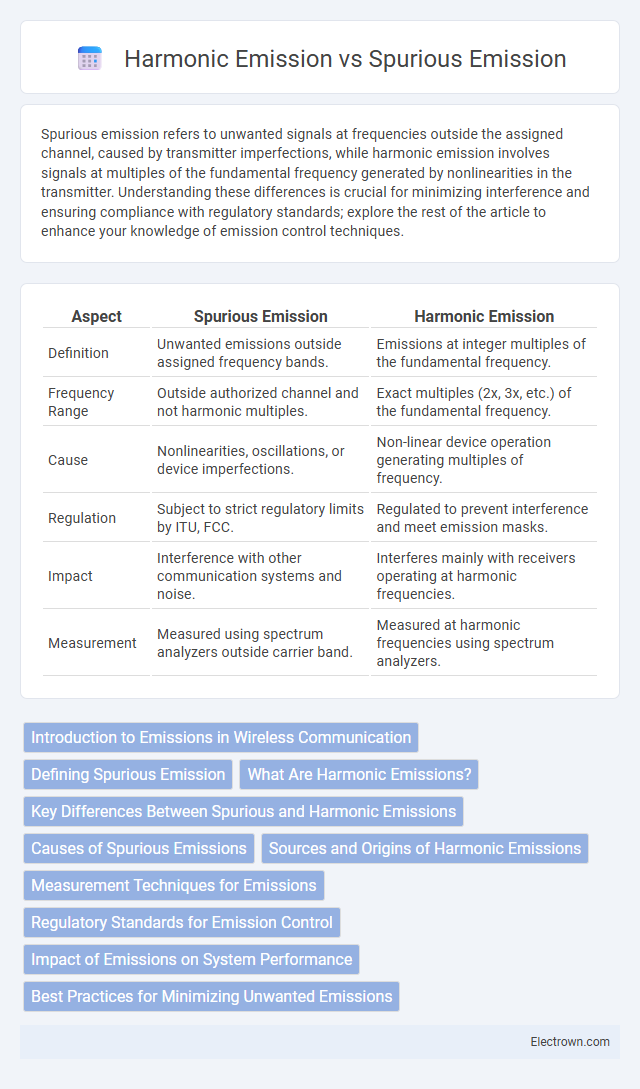Spurious emission refers to unwanted signals at frequencies outside the assigned channel, caused by transmitter imperfections, while harmonic emission involves signals at multiples of the fundamental frequency generated by nonlinearities in the transmitter. Understanding these differences is crucial for minimizing interference and ensuring compliance with regulatory standards; explore the rest of the article to enhance your knowledge of emission control techniques.
Table of Comparison
| Aspect | Spurious Emission | Harmonic Emission |
|---|---|---|
| Definition | Unwanted emissions outside assigned frequency bands. | Emissions at integer multiples of the fundamental frequency. |
| Frequency Range | Outside authorized channel and not harmonic multiples. | Exact multiples (2x, 3x, etc.) of the fundamental frequency. |
| Cause | Nonlinearities, oscillations, or device imperfections. | Non-linear device operation generating multiples of frequency. |
| Regulation | Subject to strict regulatory limits by ITU, FCC. | Regulated to prevent interference and meet emission masks. |
| Impact | Interference with other communication systems and noise. | Interferes mainly with receivers operating at harmonic frequencies. |
| Measurement | Measured using spectrum analyzers outside carrier band. | Measured at harmonic frequencies using spectrum analyzers. |
Introduction to Emissions in Wireless Communication
Emissions in wireless communication consist of unwanted signals radiated by a transmitter, including spurious emissions and harmonic emissions, both of which can interfere with other devices. Spurious emissions refer to signals emitted outside the authorized frequency band due to imperfections in the transmitter, while harmonic emissions are signals at integer multiples of the fundamental frequency generated by non-linearities in the system. Understanding the differences between these emissions helps you optimize transmitter design and ensure compliance with regulatory standards to minimize interference.
Defining Spurious Emission
Spurious emission refers to any unwanted signal generated by a transmitter that occurs outside its assigned frequency band and is not a harmonic of the fundamental frequency. These emissions can cause interference with other communication systems and must be minimized to meet regulatory standards. Your transmission system's performance depends on effectively controlling spurious emissions to ensure compliance and avoid disruptions.
What Are Harmonic Emissions?
Harmonic emissions are unwanted signals generated at integer multiples of the fundamental frequency produced by electronic devices and transmitters, causing interference with nearby communication channels. These emissions originate from nonlinearities in circuits, such as amplifiers or oscillators, and can degrade the performance of wireless systems by overlapping with other frequency bands. Controlling harmonic emissions is essential for meeting regulatory standards and ensuring efficient spectrum use in telecommunications.
Key Differences Between Spurious and Harmonic Emissions
Spurious emissions refer to unwanted radio frequency signals emitted outside the authorized frequency band, often caused by device imperfections or intermodulation products, while harmonic emissions are specific multiples of the fundamental frequency generated by nonlinearities in the transmitter. Spurious emissions can appear at any frequency and cause interference across a broad spectrum, whereas harmonic emissions are predictable and occur at integer multiples of the original signal frequency. Understanding these distinctions is essential for ensuring your transmission equipment complies with regulatory standards and minimizes interference.
Causes of Spurious Emissions
Spurious emissions arise from non-linearities in transmitter components, such as mixers, oscillators, and power amplifiers, leading to unwanted signals outside the intended frequency band. These emissions are often caused by intermodulation products, parasitic oscillations, and frequency conversions that occur during signal processing. Unlike harmonic emissions, which are integer multiples of the fundamental frequency, spurious emissions can occur at any frequency and degrade overall spectrum efficiency.
Sources and Origins of Harmonic Emissions
Harmonic emissions originate primarily from nonlinearities in electronic circuits, such as amplifiers, mixers, and oscillators operating beyond their linear range, causing the generation of signals at integer multiples of the fundamental frequency. These emissions can also arise from power supply fluctuations and semiconductor device imperfections that distort the input signal. Understanding these sources helps you mitigate unwanted harmonic distortion and maintain compliance with electromagnetic interference standards.
Measurement Techniques for Emissions
Measurement techniques for spurious emissions involve using spectrum analyzers with high dynamic range and appropriate resolution bandwidths to identify unwanted signals outside the allocated frequency band. Harmonic emissions are typically measured by capturing signal power at integer multiples of the fundamental frequency using a combination of spectrum analyzers and calibrated antenna setups. You should ensure accurate test conditions, including antenna positioning and environment control, to reliably quantify both spurious and harmonic emissions for compliance with regulatory standards.
Regulatory Standards for Emission Control
Regulatory standards for emission control, such as those set by the FCC and ITU, strictly differentiate between spurious emissions and harmonic emissions to ensure electromagnetic compatibility and reduce interference. Spurious emissions encompass unwanted signals outside the necessary bandwidth, while harmonic emissions specifically refer to multiples of the fundamental transmission frequency. Your compliance with these standards requires precise measurement and mitigation strategies to limit both types of emissions within prescribed limits.
Impact of Emissions on System Performance
Spurious emissions degrade system performance by causing unwanted interference across adjacent channels, reducing signal clarity and increasing error rates in communication networks. Harmonic emissions generate frequency multiples of the fundamental signal that can interfere with other electronic devices and violate regulatory standards, leading to potential system shutdowns or fines. Effective filtering and adherence to emission limits are crucial for maintaining overall system integrity and avoiding performance degradation.
Best Practices for Minimizing Unwanted Emissions
Minimizing spurious and harmonic emissions requires precision in transmitter design and signal filtering. Implementing high-quality bandpass filters and maintaining linear amplification help reduce unwanted signals outside the intended frequency band. You should also regularly test emission levels using spectrum analyzers to ensure compliance with regulatory standards and optimize antenna placement for cleaner transmission.
Spurious Emission vs Harmonic Emission Infographic

 electrown.com
electrown.com